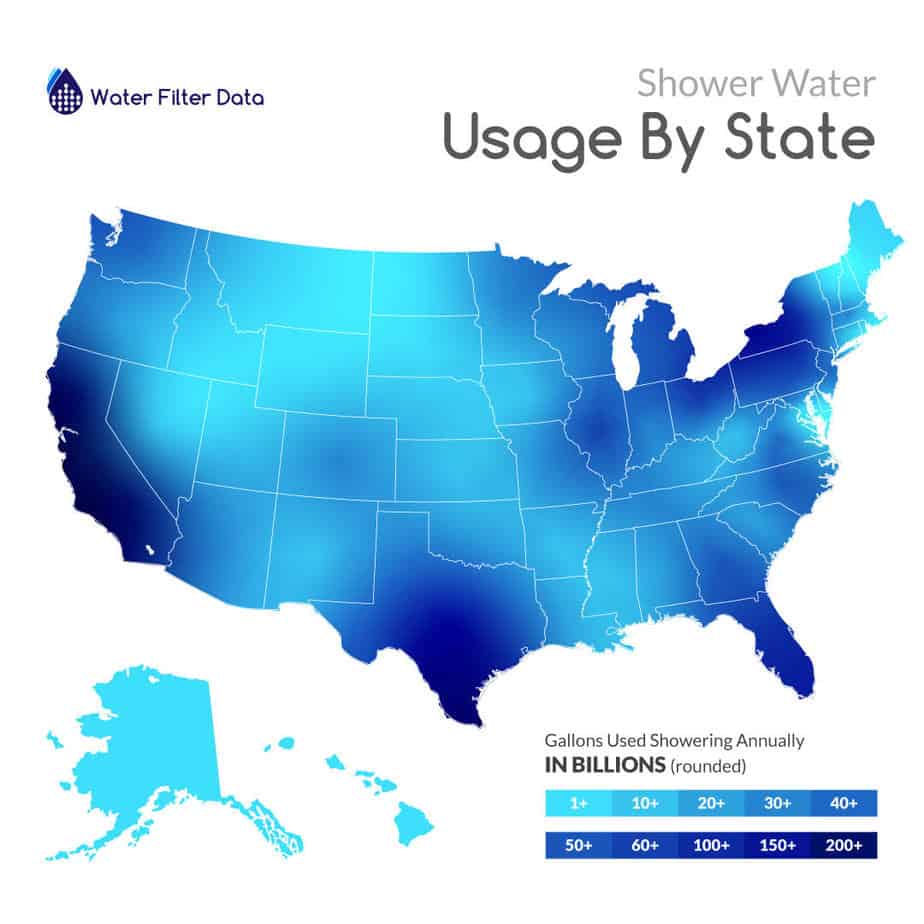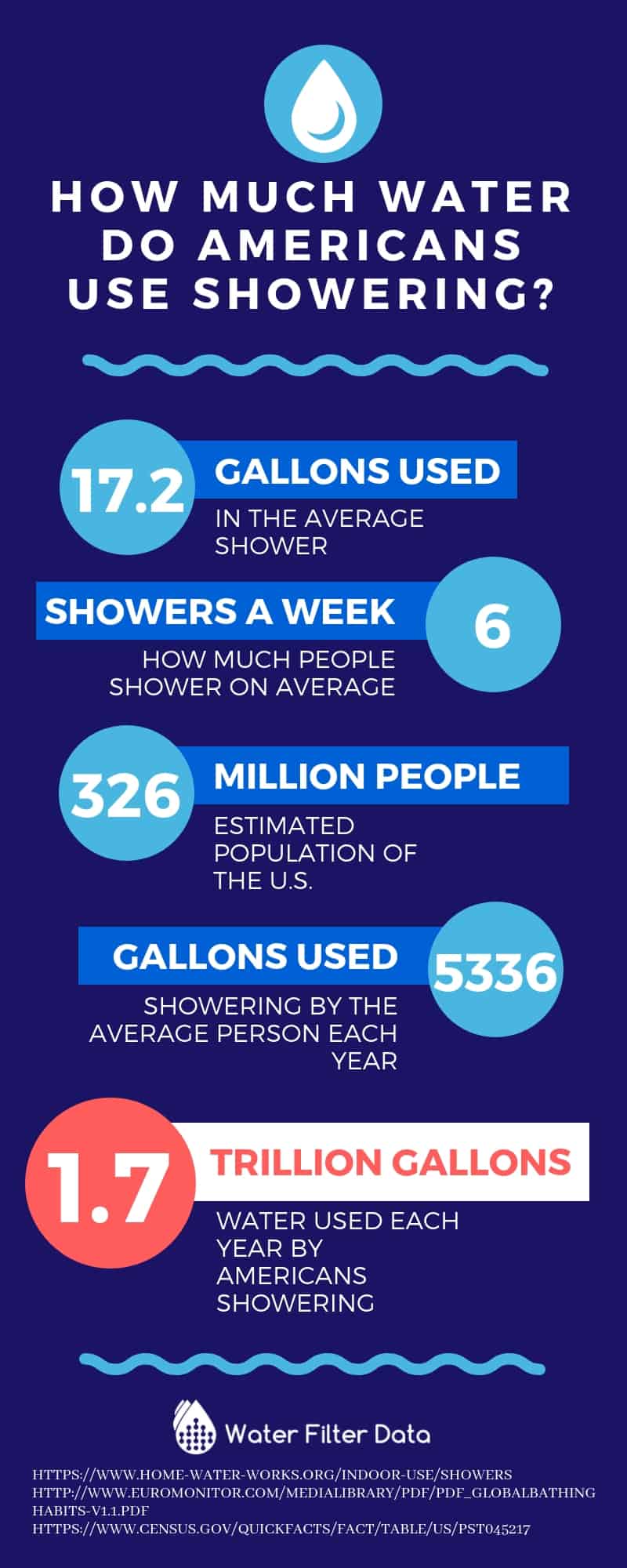We like to share product recommendations with you and hope you like them! Just to make you aware Water Filter Data may collect a small share of sales or other compensation from the links on this page.
Americans take cleanliness seriously — to the point that the average American reports taking about 6 showers per week, helping fuel a multibillion-dollar body soap industry. But while we’re all for good hygiene (no one likes being stuck next to a foul-smelling person on a bus or plane), it’s worth pausing for a moment to think about just how much water all of this bathing consumes on a national scale.
Showers are usually the third largest use of water in the typical American home, accounting for around 17 percent of the water we use indoors. And according to Home Water Works, a website created by the Alliance for Water Efficiency, the average shower is 8.2 minutes and uses 17.2 gallons of water. Baths use even more water, about 35-50 gallons of water on average.
Knowing that the average American showers about 6 times per week (according to multiple surveys from Euromonitor, SCA, and others), that means the typical person uses 5,336.4 gallons of water showering each year. But here’s where it gets really scary. With an estimated population of 325.7 million according to the US Census Bureau, Americans as a whole use a total of 1.7 trillion gallons a year showering. That’s 33.6 billion gallons of water every week! And remember, this is a conservative estimate that doesn’t factor in those who take baths, which use 2-3 times more water. It’s hard to visualize just how much 1.7 trillion gallons of water really is, but let’s try to put that into perspective:
- It’s enough to fill 2.6 million Olympic swimming pools
- It’s enough to fill all the NFL and Division 1 college football stadiums more than 10 times over
- It’s more than the capacity of Florida’s Lake Okeechobee
- It’s more than 15% of the water needed to replenish California’s drought losses, according to NASA
- It’s enough to fulfill the water usage of New York City for nearly 5 years
Shower Water Usage by State

How much water do residents in your state use every year just running the shower? Check out the map above to see the biggest users.
Here’s the full data:
| State | Gallons Used Showering Annually (in Billions, Rounded) |
| 1. California | 211 |
| 2. Texas | 151 |
| 3. Florida | 112 |
| 4. New York | 106 |
| 5. Pennsylvania | 68 |
| 6. Illinois | 68 |
| 7. Ohio | 62 |
| 8. Georgia | 56 |
| 9. North Carolina | 55 |
| 10. Michigan | 53 |
| 11. New Jersey | 48 |
| 12. Virginia | 45 |
| 13. Washington | 40 |
| 14. Arizona | 37 |
| 15. Massachusetts | 37 |
| 16. Tennessee | 36 |
| 17. Indiana | 36 |
| 18. Missouri | 33 |
| 19. Maryland | 32 |
| 20. Wisconsin | 31 |
| 21. Colorado | 30 |
| 22. Minnesota | 30 |
| 23. South Carolina | 27 |
| 24. Alabama | 26 |
| 25. Louisiana | 25 |
| 26. Kentucky | 24 |
| 27. Oregon | 22 |
| 28. Oklahoma | 21 |
| 29. Connecticut | 19 |
| 30. Iowa | 17 |
| 31. Utah | 17 |
| 32. Arkansas | 16 |
| 33. Nevada | 16 |
| 34. Mississippi | 16 |
| 35. Kansas | 16 |
| 36. New Mexico | 11 |
| 37. Nebraska | 10 |
| 38. West Virginia | 10 |
| 39. Idaho | 9 |
| 40. Hawaii | 8 |
| 41. New Hampshire | 7 |
| 42. Maine | 7 |
| 43. Rhode Island | 6 |
| 44. Montana | 6 |
| 45. Delaware | 5 |
| 46. South Dakota | 5 |
| 47. North Dakota | 4 |
| 48. Alaska | 4 |
| 49. Vermont | 3 |
| 50. Wyoming | 3 |
Shower Water Usage in America’s Top Cities
America’s 20 biggest cities together use about 184 billion gallons of water annually just from showering. Here’s how much each city uses on its own:
| City | Gallons Used Showering Annually (in Billions, Rounded) |
| New York City | 46 |
| Los Angeles | 21.3 |
| Chicago | 14.5 |
| Houston | 12.3 |
| Phoenix | 8.7 |
| Philadelphia | 8.4 |
| San Antonio | 8.1 |
| San Diego | 7.6 |
| Dallas | 7.2 |
| San Jose | 5.5 |
| Austin | 5.1 |
| Jacksonville | 4.8 |
| San Francisco | 4.7 |
| Columbus | 4.7 |
| Fort Worth | 4.7 |
| Indianapolis | 4.6 |
| Charlotte | 4.6 |
| Seattle | 3.9 |
| Denver | 3.8 |
| Washington, DC | 3.7 |
How to Reduce Your Shower Water Usage
We live in a world where drought plagues us both close to home (California) and in many places far away (such as Ethiopia), and water scarcity issues are expected to worsen in the years to come. It’s important for everyone to consider their water footprint and to take steps to reduce it where possible. Even if you don’t live in an area where droughts are a serious concern, there’s still the fact that running a shower (especially a hot one) consumes energy. It takes energy to treat, deliver, and heat the water to your home, and once that water goes down your tub drain, it takes energy to treat it again before it can be reused. Plus, with water utility rates rising at over 3x the rate of inflation, you’ll want to save on your bill wherever possible. With that in mind, there are a few things we can all do to use less water in the shower:
- Use a low-flow showerhead. Regular showerheads use 2.5 gallons of water per minute, but a low-flow showerhead uses 2 gallons of water per minute or less. To put that into perspective, if everyone in the US switched to a low-flow showerhead, we’d save over 300 billion gallons of water each year from that alone.
- Spend less time in the shower. If you’re someone who likes a long, hot shower, try to cut back on the amount of time you spend in the shower. It’s the easiest and least expensive way to conserve water.
- Capture and reuse the cold water that comes out when waiting for the shower to warm up. By putting a bucket in the shower when you first turn it on, you can use the water you catch while waiting for it to warm up for other purposes, like watering your plants or cleaning tasks.
We’d love to know: How often do you shower every week? How long are your showers?
Can the World Run Out of Clean Water?
It’s a scary thought. Can the world run out of water? If we fail to control our excessively long showers or multi-weekly baths, could we possibly use up all the water in the oceans?
The short answer is no; we cannot dry out the oceans. Get this – there are 352 quintillion gallons of water in the oceans. Compared to the amount Americans and the world use yearly, it would take years and years to burn through our water reserve. It may be impossible because of the endless water cycle, meaning water never really leaves the earth.
So, what is the fuss about water usage if we have an endless water supply?
There is a caution to manage water consumption because potable water is limited. We cannot drink water from the oceans because of its high salt concentration, which would require numerous treatments before it becomes safe for consumption.
Fresh water comes from ground sources facilitated by precipitation. But rainfall has a seasonal tendency, so the rivers will not always overflow. Besides, it is important to consider the effect of purifying water and how it affects the environment.
The world cannot run out of water per se, but it is still important to consider where water comes from and the environmental impacts of treating and passing it around.
Conclusion
There are many shocking facts about global consumption. Water seems like a limitless resource, and it is. However, potable water sources are limited, and it is estimated that 66 percent of the world will experience a water shortage several decades from now. Although it may not happen immediately, chances are that day is coming unless we change our consumption habits.
You can take shorter showers, invest in low-pressure showerheads, and divert your resources to cosmetic products that don’t require additional water consumption. In cases where you can use an alternative like environmentally friendly wipes, go for it!
FAQs
How many gallons of water does the average American use daily?
Each minute, your showerhead releases 2.1 gallons per minute, and the average shower requires 17.2 gallons of water per day. This is presuming you spend just a little above eight minutes long, which is also average for American showers. In contrast, using a typical bathtub consumes about thirty-five gallons; larger bathtubs and Jacuzzis consume even higher.
What is the annual household water usage?
If you live in America, you are probably one of the 130 million households accounted for. The average household is estimated to consume 300 gallons daily, which amounts to 109,500 gallons every 365 days.
How can I use less water in the shower?
If you are used to long showers, you can reduce the time you spend in the bathroom by investing in products that lather less. For instance, no-rinse shampoo is an alternative that helps you divert less water to your hair.
You can also use less water by turning off the taps when you are not actively trying to rinse or wet your body.
We’d love to know: How often do you shower every week? How long are your showers?


Wayne is a water quality expert – The founder of Water Filter Data. He has a degree in microbiology and his field of expertise is drinking water. His goal is to allow for clean and healthy water for as many people as possible.



